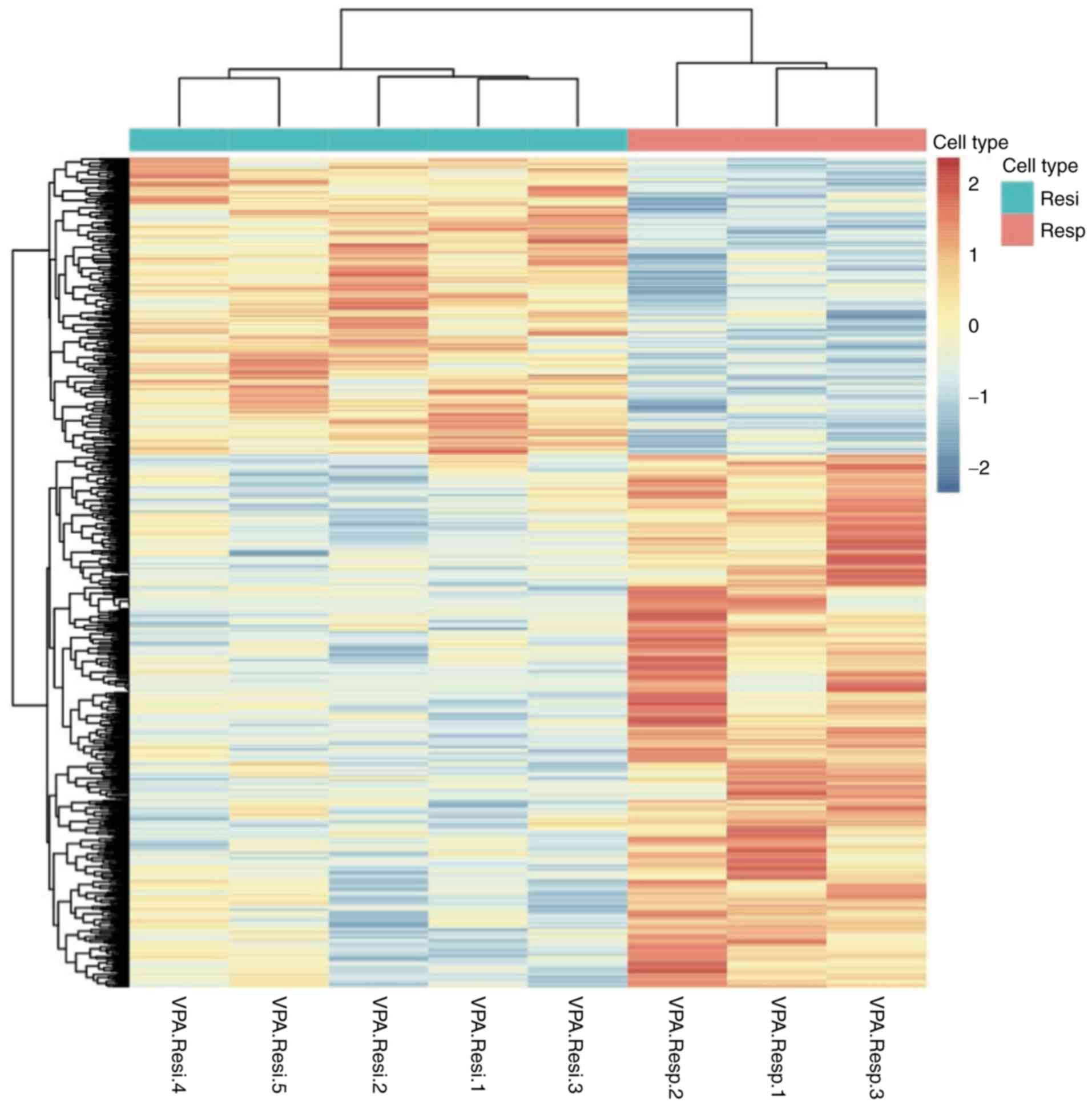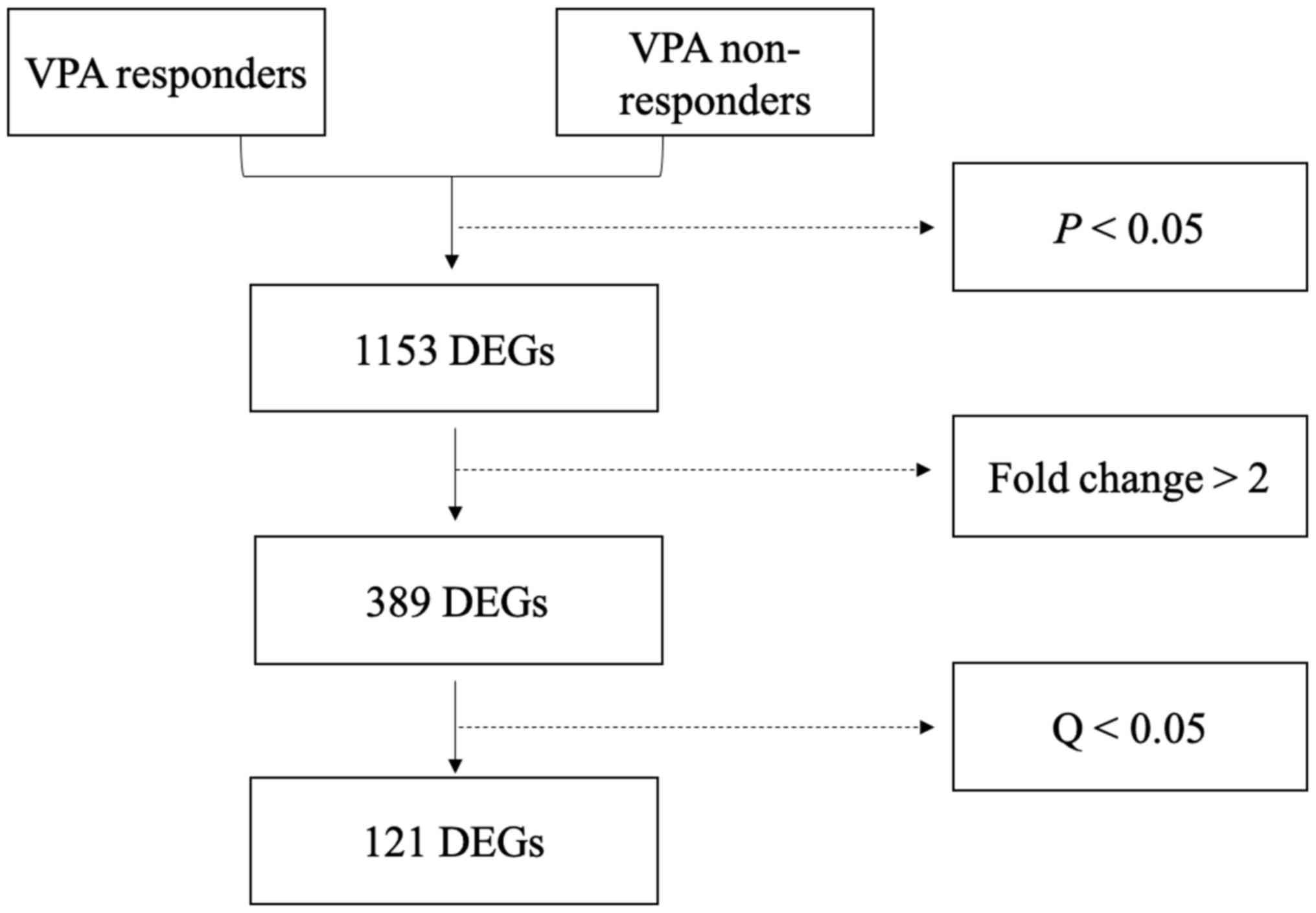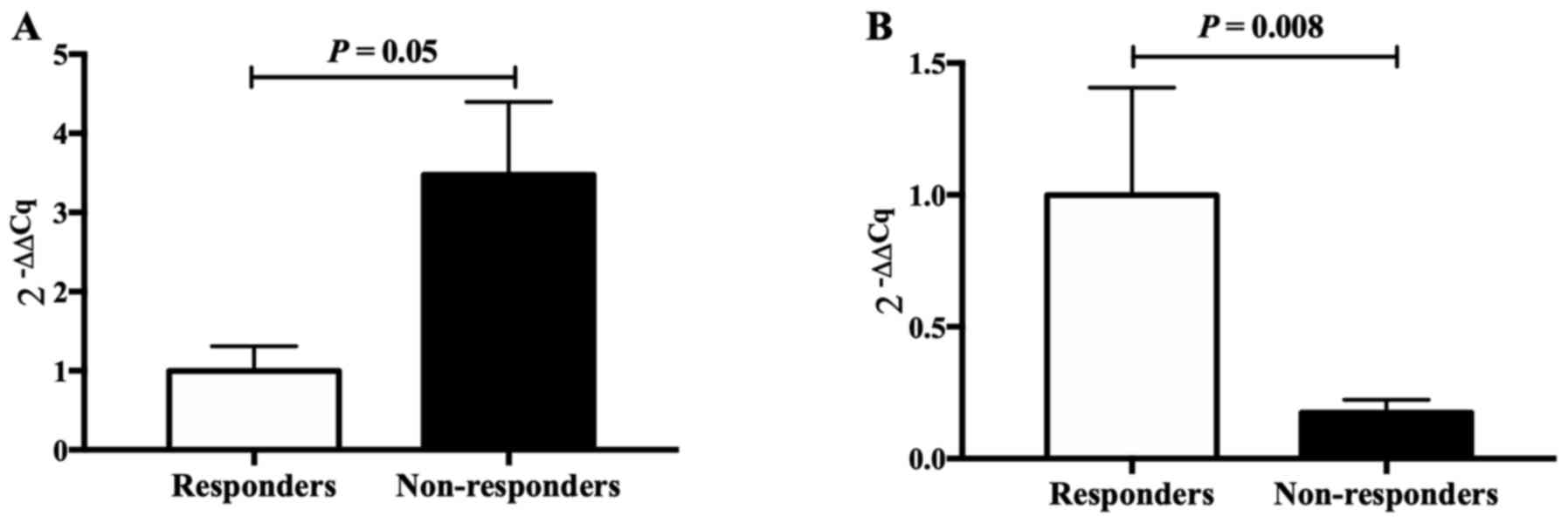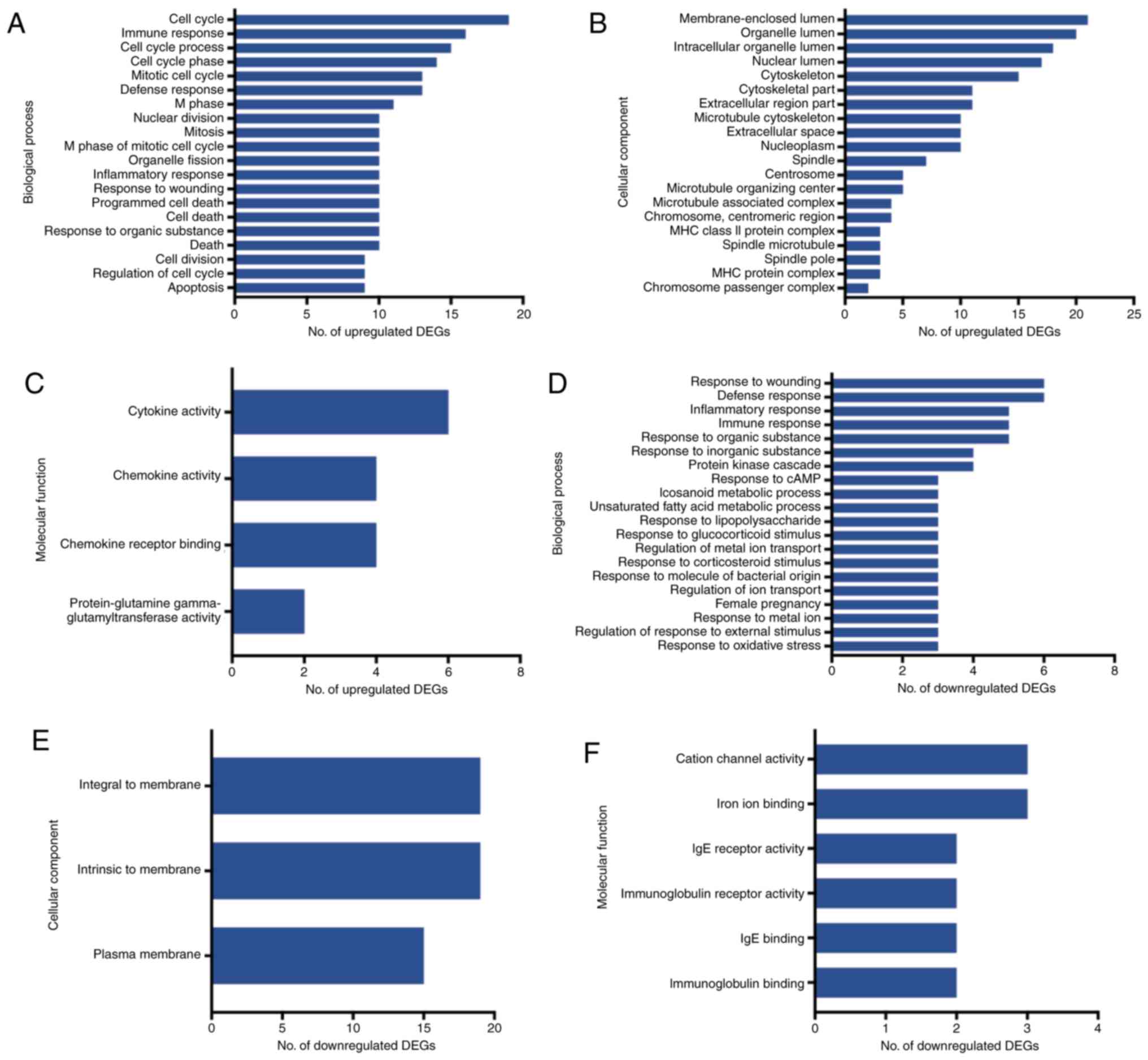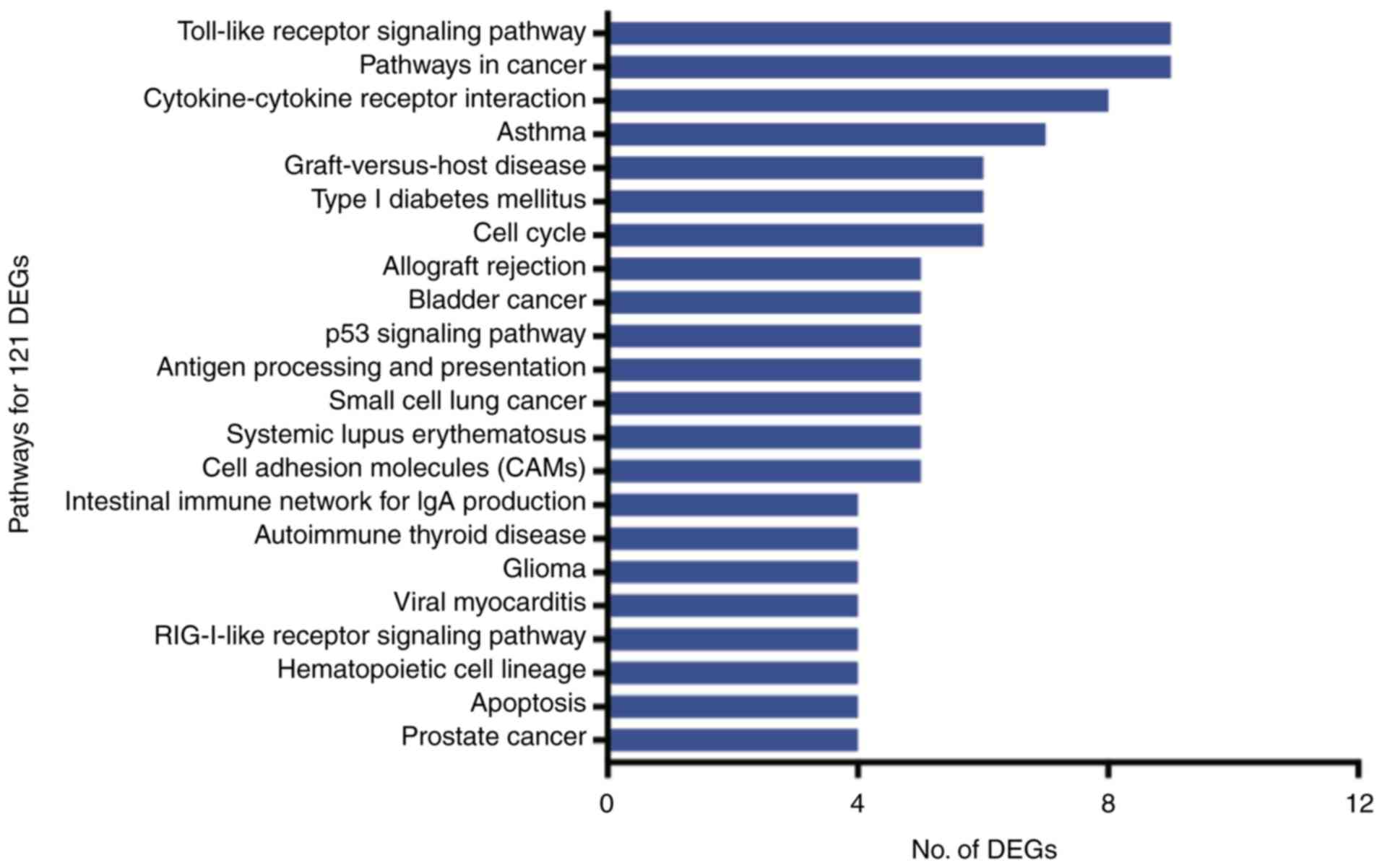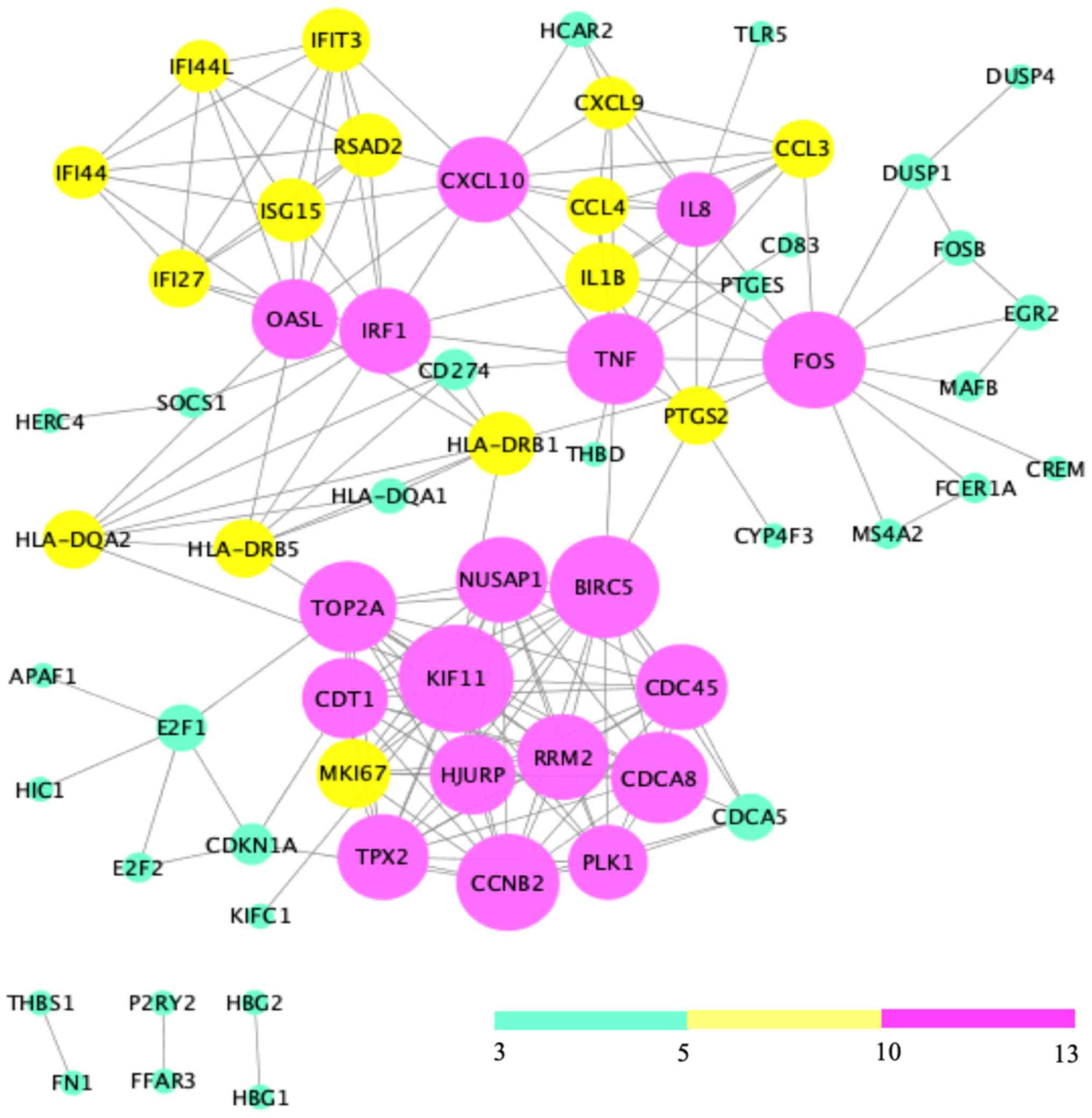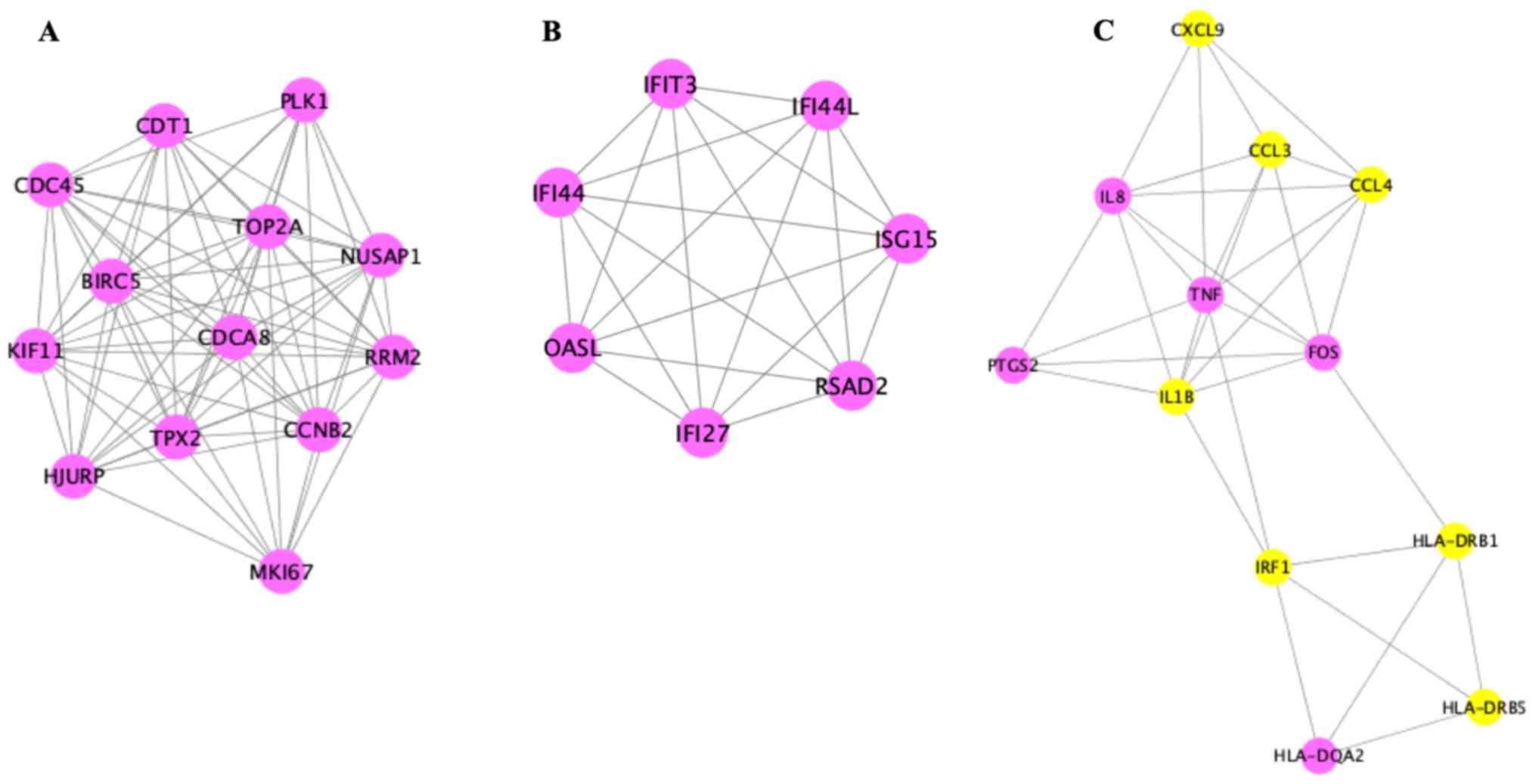|
1
|
Singh A and Trevick S: The epidemiology of
global epilepsy. Neurol Clin. 34:837–847. 2016. View Article : Google Scholar : PubMed/NCBI
|
|
2
|
Lv RJ, Shao XQ, Cui T and Wang Q:
Significance of MDR1 gene C3435T polymorphism in predicting
childhood refractory epilepsy. Epilepsy Res. 132:21–28. 2017.
View Article : Google Scholar : PubMed/NCBI
|
|
3
|
Voll A, Hernández-Ronquillo L, Buckley S
and Téllez-Zenteno JF: Predicting drug resistance in adult patients
with generalized epilepsy: A case-control study. Epilepsy Behav.
53:126–130. 2015. View Article : Google Scholar : PubMed/NCBI
|
|
4
|
Rakitin A, Kõks S and Haldre S: Valproate
modulates glucose metabolism in patients with epilepsy after first
exposure. Epilepsia. 56:e172–e175. 2015. View Article : Google Scholar : PubMed/NCBI
|
|
5
|
Fernando-Dongas MC, Radtke RA,
Vanlandingham KE and Husain AM: Characteristics of valproic acid
resistant juvenile myoclonic epilepsy. Seizure. 9:385–388. 2000.
View Article : Google Scholar : PubMed/NCBI
|
|
6
|
Nevitt ST, Sudell M, Weston J, Tudur Smith
C and Marson AG: Antiepileptic drug monotherapy for epilepsy: A
network meta-analysis of individual participant data. Cochrane
Database Syst Rev. 6:CD01141212017.
|
|
7
|
Brigo F, Igwe SC and Lattanzi S:
Ethosuximide, sodium valproate or lamotrigine for absence seizure
in children and adolescents. Cochrane Database Syst Rev.
2:CD0030322019.PubMed/NCBI
|
|
8
|
Yasiry Z and Shorvon SD: The relative
effectiveness of five antiepileptic drugs in treatment of
benzodiazepine-resistant convulsive status epilepticus: A
meta-analysis of published studies. Seizure. 23:167–174. 2014.
View Article : Google Scholar : PubMed/NCBI
|
|
9
|
Trinka E, Höfler J, Zerbs A and Brigo F:
Efficacy and safety of intravenous valproate for status
epilepticus: A systematic review. CNS Drugs. 28:623–639. 2014.
View Article : Google Scholar : PubMed/NCBI
|
|
10
|
Gesche J, Khanevski M, Solberg C and Beier
CP: Resistance to valproic acid as predictor of treatment
resistance in genetic generalized epilepsies. Epilepsia.
58:E64–E69. 2017. View Article : Google Scholar : PubMed/NCBI
|
|
11
|
Luna-Tortós C, Fedrowitz M and Löscher W:
Evaluation of transport of common antiepileptic drugs by human
multidrug resistance-associated proteins (MRP1, 2 and 5) that are
overexpressed in pharmacoresistant epilepsy. Neuropharmacology.
58:1019–1032. 2010. View Article : Google Scholar : PubMed/NCBI
|
|
12
|
Baltes S, Fedrowitz M, Tortos CL, Potschka
H and Löscher W: Valproic acid is not a substrate for
P-glycoprotein or multidrug resistance proteins 1 and 2 in a number
of in vitro and in vivo transport assays. J Pharmacol Exp Ther.
320:331–343. 2007. View Article : Google Scholar : PubMed/NCBI
|
|
13
|
Moerman L, Wyffels L, Slaets D, Raedt R,
Boon P and De Vos F: Antiepileptic drugs modulate P-glycoproteins
in the brain: A mice study with (11)C-desmethylloperamide. Epilepsy
Res. 94:18–25. 2011. View Article : Google Scholar : PubMed/NCBI
|
|
14
|
Römermann K, Helmer R and Löscher W: The
antiepileptic drug lamotrigine is a substrate of mouse and human
breast cancer resistance protein (ABCG2). Neuropharmacology.
93:7–14. 2015. View Article : Google Scholar : PubMed/NCBI
|
|
15
|
Zhou L, Cao Y, Long H, Long L, Xu L, Liu
Z, Zhang Y and Xiao B: ABCB1, ABCC2, SCN1A, SCN2A, GABRA1 gene
polymorphisms and drug resistant epilepsy in the Chinese Han
population. Pharmazie. 70:416–420. 2015.PubMed/NCBI
|
|
16
|
Balan S, Sathyan S, Radha SK, Joseph V,
Radhakrishnan K and Banerjee M: GABRG2, rs211037 is associated with
epilepsy susceptibility, but not with antiepileptic drug resistance
and febrile seizures. Pharmacogenet Genomics. 23:605–610. 2013.
View Article : Google Scholar : PubMed/NCBI
|
|
17
|
Singh E, Pillai KK and Mehndiratta M:
Characterization of a lamotrigine-resistant kindled model of
epilepsy in mice: Evaluation of drug resistance mechanisms. Basic
Clin Pharmacol Toxicol. 115:373–378. 2014. View Article : Google Scholar : PubMed/NCBI
|
|
18
|
Glauser TA, Holland K, O'Brien VP,
Keddache M, Martin L, Clark PO, Cnaan A, Dlugos D, Hirtz DG6
Shinnar S, et al: Pharmacogenetics of antiepileptic drug efficacy
in childhood absence epilepsy. Ann Neurol. 81:444–453. 2017.
View Article : Google Scholar : PubMed/NCBI
|
|
19
|
Lv N, Qu J, Long H, Zhou L, Cao Y, Long L,
Liu Z and Xiao B: Association study between polymorphisms in the
CACNA1A, CACNA1C, and CACNA1H genes and drug-resistant epilepsy in
the Chinese Han population. Seizure. 30:64–69. 2015. View Article : Google Scholar : PubMed/NCBI
|
|
20
|
Mou P, Chen Z, Jiang L, Cheng J and Wei R:
PTX3: A potential biomarker in thyroid associated ophthalmopathy.
Biomed Res Int. 2018:59619742018. View Article : Google Scholar : PubMed/NCBI
|
|
21
|
Waters WR, Maggioli MF, Palmer MV, Thacker
TC, McGill JL, Vordermeier HM, Berney-Meyer L, Jacobs WR Jr and
Larsen MH: Interleukin-17A as a Biomarker for bovine tuberculosis.
Clin Vaccine Immunol. 23:168–180. 2015. View Article : Google Scholar : PubMed/NCBI
|
|
22
|
Satoh J, Yamamoto Y, Asahina N, Kitano S
and Kino Y: RNA-Seq data mining: Downregulation of NeuroD6 serves
as a possible biomarker for alzheimer's disease brains. Dis
Markers. 2014:1231652014. View Article : Google Scholar : PubMed/NCBI
|
|
23
|
Pong WW, Walker J, Wylie T, Magrini V, Luo
J, Emnett RJ, Choi J, Cooper ML, Griffith M, Griffith OL, et al:
F11R is a novel monocyte prognostic biomarker for malignant glioma.
PLoS One. 8:e775712013. View Article : Google Scholar : PubMed/NCBI
|
|
24
|
Dixit AB, Banerjee J, Srivastava A,
Tripathi M, Sarkar C, Kakkar A, Jain M and Chandra PS: RNA-seq
analysis of hippocampal tissues reveals novel candidate genes for
drug refractory epilepsy in patients with MTLE-HS. Genomics.
107:178–188. 2016. View Article : Google Scholar : PubMed/NCBI
|
|
25
|
Griffin NG, Wang Y, Hulette CM, Halvorsen
M, Cronin KD, Walley NM, Haglund MM, Radtke RA, Skene JH, Sinha SR
and Heinzen EL: Differential gene expression in dentate granule
cells in mesial temporal lobe epilepsy with and without hippocampal
sclerosis. Epilepsia. 57:376–385. 2016. View Article : Google Scholar : PubMed/NCBI
|
|
26
|
Liew CC, Ma J, Tang HC, Zheng R and
Dempsey AA: The peripheral blood transcriptome dynamically reflects
system wide biology: A potential diagnostic tool. J Lab Clin Med.
147:126–132. 2006. View Article : Google Scholar : PubMed/NCBI
|
|
27
|
Borovecki F, Lovrecic L, Zhou J, Jeong H,
Then F, Rosas HD, Hersch SM, Hogarth P, Bouzou B, Jensen RV and
Krainc D: Genome-wide expression profiling of human blood reveals
biomarkers for Huntington's disease. Proc Natl Acad Sci USA.
102:11023–11028. 2005. View Article : Google Scholar : PubMed/NCBI
|
|
28
|
Jergil M, Forsberg M, Salter H, Stockling
K, Gustafson AL, Dencker L and Stigson M: Short-time gene
expression response to valproic acid and valproic acid analogs in
mouse embryonic stem cells. Toxicol Sci. 121:328–342. 2011.
View Article : Google Scholar : PubMed/NCBI
|
|
29
|
Dozawa M, Kono H, Sato Y, Ito Y, Tanaka H
and Ohshima T: Valproic acid, a histone deacetylase inhibitor,
regulates cell proliferation in the adult zebrafish optic tectum.
Dev Dyn. 243:1401–1415. 2014. View Article : Google Scholar : PubMed/NCBI
|
|
30
|
Van Lint C, Emiliani S and Verdin E: The
expression of a small fraction of cellular genes is changed in
response to histone hyperacetylation. Gene Expr. 5:245–253.
1996.PubMed/NCBI
|
|
31
|
Rakitin A, Kõks S, Reimann E, Prans E and
Haldre S: Changes in the peripheral blood gene expression profile
induced by 3 months of valproate treatment in patients with newly
diagnosed epilepsy. Front Neurol. 6:1882015. View Article : Google Scholar : PubMed/NCBI
|
|
32
|
Floriano-Sánchez E, Brindis F,
Ortega-Cuellar D, Ignacio-Mejía I, Moreno-Arriola E, Romero-Morelos
P, Ceballos-Vasquez E, Córdova-Espinoza MG, Arregoitia-Sarabia CK,
Sandoval-Pacheco R, et al: Differential gene expression profile
induced by valproic acid (VPA) in pediatric epileptic patients.
Genes (Basel). 9(pii): E3282018. View Article : Google Scholar : PubMed/NCBI
|
|
33
|
Kwan P, Arzimanoglou A, Berg AT, Brodie
MJ, Allen Hauser W, Mathern G, Moshé SL, Perucca E, Wiebe S and
French J: Definition of drug resistant epilepsy: Consensus proposal
by the ad hoc task force of the ILAE commission on therapeutic
Strategies. Epilepsia. 51:1069–1077. 2010. View Article : Google Scholar : PubMed/NCBI
|
|
34
|
Berg AT, Berkovic SF, Brodie MJ,
Buchhalter J, Cross JH, van Emde Boas W, Engel J, French J, Glauser
TA, Mathern GW, et al: Revised terminology and concepts for
organization of seizures and epilepsies: Report of the ILAE
commission on classification and terminology, 2005–2009. Epilepsia.
51:676–685. 2010. View Article : Google Scholar : PubMed/NCBI
|
|
35
|
Livak KJ and Schmittgen TD: Analysis of
relative gene expression data using real-time quantitative PCR and
the 2(-Delta Delta C(T)) Method. Methods. 25:402–408. 2001.
View Article : Google Scholar : PubMed/NCBI
|
|
36
|
Huang DW, Sherman BT, Tan Q, Collins JR,
Alvord WG, Roayaei J, Stephens R, Baseler MW, Lane HC and Lempicki
RA: The DAVID gene functional classification tool: A novel
biological module-centric algorithm to functionally analyze large
gene lists. Genome Biol. 8:R1832007. View Article : Google Scholar : PubMed/NCBI
|
|
37
|
Brahma R, Gurumayum S, Naorem LD,
Muthaiyan M, Gopal J and Venkatesan A: Identification of hub genes
and pathways in Zika Virus infection using RNA-Seq Data: A
network-based computational approach. Viral Immunol. 31:321–332.
2018. View Article : Google Scholar : PubMed/NCBI
|
|
38
|
Kan AA, de Jager W, de Wit M, Heijnen C,
van Zuiden M, Ferrier C, van Rijen P, Gosselaar P, Hessel E, van
Nieuwenhuizen O and de Graan PN: Protein expression profiling of
inflammatory mediators in human temporal lobe epilepsy reveals
co-activation of multiple chemokines and cytokines. J
Neuroinflammation. 9:2072012. View Article : Google Scholar : PubMed/NCBI
|
|
39
|
Louboutin JP, Chekmasova A, Marusich E,
Agrawal L and Strayer DS: Role of CCR5 and its ligands in the
control of vascular inflammation and leukocyte recruitment required
for acute excitotoxic seizure induction and neural damage. FASEB J.
25:737–753. 2011. View Article : Google Scholar : PubMed/NCBI
|
|
40
|
Pocock JM and Liddle AC: Microglial
signalling cascades in neurodegenerative disease. Prog Brain Res.
132:555–565. 2001. View Article : Google Scholar : PubMed/NCBI
|
|
41
|
Chui R and Dorovini-Zis K: Regulation of
CCL2 and CCL3 expression in human brain endothelial cells by
cytokines and lipopolysaccharide. J Neuroinflammation. 7:12010.
View Article : Google Scholar : PubMed/NCBI
|
|
42
|
De Simoni MG, Perego C, Ravizza T, Moneta
D, Conti M, Marchesi F, De Luigi A, Garattini S and Vezzani A:
Inflammatory cytokines and related genes are induced in the rat
hippocampus by limbic status epilepticus. Eur J Neurosci.
12:2623–2633. 2000. View Article : Google Scholar : PubMed/NCBI
|
|
43
|
Jin W, Zhang J, Lou D, Chavkin C and Xu M:
C-fos-deficient mouse hippocampal CA3 pyramidal neurons exhibit
both enhanced basal and kainic acid-induced excitability. Neurosci
Lett. 331:151–154. 2002. View Article : Google Scholar : PubMed/NCBI
|
|
44
|
Zhang J, Zhang D, McQuade JS, Behbehani M,
Tsien JZ and Xu M: c-fos regulates neuronal excitability and
survival. Nat Genet. 30:416–420. 2002. View
Article : Google Scholar : PubMed/NCBI
|
|
45
|
Tang Y, Glauser TA, Gilbert DL, Hershey
AD, Privitera MD, Ficker DM, Szaflarski JP and Sharp FR: Valproic
acid blood genomic expression patterns in children with epilepsy-a
pilot study. Acta Neurol Scand. 109:159–168. 2004. View Article : Google Scholar : PubMed/NCBI
|
|
46
|
Minnier J, Pennock ND, Guo Q, Schedin P
and abd Harrington CA: RNA-Seq and expression arrays: Selection
guidelines for genome-wide expression profiling. Methods Mol Bio.
1783:7–33. 2018. View Article : Google Scholar
|
|
47
|
Zhao S, Fung-Leung WP, Bittner A, Ngo K
and Liu X: Comparison of RNA-Seq and microarray in transcriptome
profiling of activated T cells. PLoS One. 9:e786442014. View Article : Google Scholar : PubMed/NCBI
|
|
48
|
Walker L and Sills GJ: Inflammation and
epilepsy: The foundations for a new therapeutic approach in
epilepsy? Epilepsy Curr. 12:8–12. 2012. View Article : Google Scholar : PubMed/NCBI
|
|
49
|
Guzik-Kornacka A, Sliwa A, Plucinska G and
Lukasiuk K: Status epilepticus evokes prolonged increase in the
expression of CCL3 and CCL4 mRNA and protein in the rat brain. Acta
Neurobiol Exp (Wars). 71:193–207. 2011.PubMed/NCBI
|
|
50
|
Owens GC, Huynh MN, Chang JW, McArthur DL,
Hickey MJ, Vinters HV, Mathern GW and Kruse CA: Differential
expression of interferon-γ and chemokine genes distinguishes
Rasmussen encephalitis from cortical dysplasia and provides
evidence for an early Th1 immune response. J Neuroinflammation.
10:562013. View Article : Google Scholar : PubMed/NCBI
|
|
51
|
Arisi GM, Foresti ML, Katki K and Shapiro
LA: Increased CCL2, CCL3, CCL5, and IL-1β cytokine concentration in
piriform cortex, hippocampus, and neocortex after
pilocarpine-induced seizures. J Neuroinflammation. 12:1292015.
View Article : Google Scholar : PubMed/NCBI
|
|
52
|
Srivastava A, Dixit AB, Paul D, Tripathi
M, Sarkar C, Chandra PS and Banerjee J: Comparative analysis of
cytokine/chemokine regulatory networks in patients with hippocampal
sclerosis (HS) and focal cortical dysplasia (FCD). Sci Rep.
7:159042017. View Article : Google Scholar : PubMed/NCBI
|
|
53
|
Saber S, Mahmoud AAA, Helal NS, El-Ahwany
E and Abdelghany RH: Renin-angiotensin system inhibition
ameliorates CCl4-induced liver fibrosis in mice through
the inactivation of nuclear transcription factor kappa B. Can J
Physiol Pharmacol. 96:569–576. 2018. View Article : Google Scholar : PubMed/NCBI
|
|
54
|
Guenther S, Bauer S, Hagge M, Knake S,
Olmes DG, Tackenberg B, Rosenow F and Hamer HM: Chronic valproate
or levetiracetam treatment does not influence cytokine levels in
humans. Seizure. 23:666–669. 2014. View Article : Google Scholar : PubMed/NCBI
|
|
55
|
Ichiyama T, Okada K, Lipton JM, Matsubara
T, Hayashi T and Furukawa S: Sodium valproate inhibits production
of TNF-alpha and IL-6 and activation of NF-kappaB. Brain Res.
857:246–251. 2000. View Article : Google Scholar : PubMed/NCBI
|
|
56
|
Ghosh C, Hossain M, Solanki J, Najm IM,
Marchi N and Janigro D: Overexpression of pregnane X and
glucocorticoid receptors and the regulation of cytochrome P450 in
human epileptic brain endothelial cells. Epilepsia. 58:576–585.
2017. View Article : Google Scholar : PubMed/NCBI
|
|
57
|
Lee NY, Riechmann P and Kang YS: The
changes of P-glycoprotein activity by interferon-γ and tumor
necrosis factor-α in primary and immortalized human brain
microvascular endothelial cells. Blomol Ther (Seoul). 20:293–298.
2012. View Article : Google Scholar
|
|
58
|
Feng W, Mei S, Zhu L, Yu Y, Yang W, Gao B,
Wu X, Zhao Z and Feng F: Effects of UGT2B7, SCN1A and CYP3A4 on the
therapeutic response of sodium valproate treatment in children with
generalized seizures. Seizure. 58:96–100. 2018. View Article : Google Scholar : PubMed/NCBI
|
|
59
|
Mantle JL and Lee KH: A differentiating
neural stem cell-derived astrocytic population mitigates the
inflammatory effects of TNF-α and IL-6 in an iPSC-based blood-brain
barrier model. Neurobiol Dis. 119:113–120. 2018. View Article : Google Scholar : PubMed/NCBI
|
|
60
|
Alluri H, Grimsley M, Anasooya Shaji C,
Varghese KP, Zhang SL, Peddaboina C, Robinson B, Beeram MR, Huang
JH and Tharakan B: Attenuation of blood-brain barrier breakdown and
hyperpermeability by calpain inhibition. J Biol Chem.
291:26958–26969. 2016. View Article : Google Scholar : PubMed/NCBI
|
|
61
|
Sakuma H, Tanuma N, Kuki I, Takahashi Y,
Shiomi M and Hayashi M: Intrathecal overproduction of
proinflammatory cytokines and chemokines in febrile
infection-related refractory status epilepticus. J Neurol Neurosurg
Psychiatry. 86:820–822. 2015. View Article : Google Scholar : PubMed/NCBI
|
|
62
|
Kuijpers M, van Gassen KL, de Graan PN and
Gruol D: Chronic exposure to the chemokine CCL3 enhances neuronal
network activity in rat hippocampal cultures. J Neuroimmunol.
229:73–80. 2010. View Article : Google Scholar : PubMed/NCBI
|
|
63
|
Anaparti V, Pascoe CD, Jha A, Mahood TH,
Ilarraza 3, Unruh H, Moqbel R and Halayko AJ: Tumor necrosis factor
regulates NMDA receptor-mediated airway smooth muscle contractile
function and airway responsiveness. Am J Physiol Lung Cell Mol
Physiol. 311:L467–480. 2016. View Article : Google Scholar : PubMed/NCBI
|
|
64
|
Zellinger C, Salvamoser JD, Soerensen J,
van Vliet EA, Aronica E, Gorter J and Potschka H: Pre-treatment
with the NMDA receptor glycine-binding site antagonist L-701,324
improves pharmacosensitivity in a mouse kindling model. Epilepsy
Res. 108:634–643. 2014. View Article : Google Scholar : PubMed/NCBI
|
|
65
|
Hung CC, Ho JL, Chang WL, Tai JJ, Hsieh
TJ, Hsieh YW and Liou HH: Association of genetic variants in six
candidate genes with valproic acid therapy optimization.
Pharmacogenomics. 12:1107–1117. 2011. View Article : Google Scholar : PubMed/NCBI
|
|
66
|
Gautier NM and Glasscock E: Spontaneous
seizures in Kcna1-null mice lacking voltage-gated Kv1.1 channels
activate Fos expression in select limbic circuits. J Neurochem.
135:157–164. 2015. View Article : Google Scholar : PubMed/NCBI
|
|
67
|
Szyndler J, Maciejak P, Turzyńska D,
Sobolewska A, Taracha E, Skórzewska A, Lehner M, Bidziński A, Hamed
A, Wisłowska-Stanek A, et al: Mapping of c-Fos expression in the
rat brain during the evolution of pentylenetetrazol-kindled
seizures. Epilepsy Behav. 16:216–224. 2009. View Article : Google Scholar : PubMed/NCBI
|
|
68
|
Cunningham JT, Mifflin SW, Gould GG and
Frazer A: Induction of c-Fos and DeltaFosB immunoreactivity in rat
brain by Vagal nerve stimulation. Neuropsychopharmacology.
33:1884–1895. 2008. View Article : Google Scholar : PubMed/NCBI
|
|
69
|
Deransart C Lê BT, Marescaux C and
Depaulis A: Role of the subthalamo-nigral input in the control of
amygdala-kindled seizures in the rat. Brain Res. 807:78–83. 1998.
View Article : Google Scholar : PubMed/NCBI
|
|
70
|
Bozzi Y, Vallone D and Borrelli E:
Neuroprotective role of dopamine against hippocampal cell death. J
Neurosci. 20:8643–8649. 2000. View Article : Google Scholar : PubMed/NCBI
|
|
71
|
Madsen TM, Bolwig TG and Mikkelsen JD:
Differential regulation of c-Fos and FosB in the rat brain after
amygdala kindling. Cell Mol Neurobiol. 26:87–100. 2006. View Article : Google Scholar : PubMed/NCBI
|















